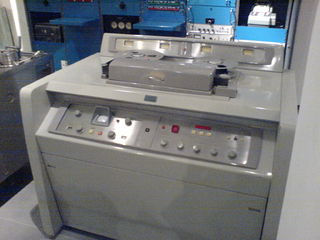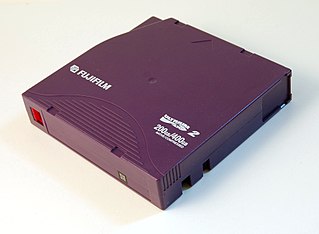
A tape drive is a data storage device that reads and writes data on a magnetic tape. Magnetic tape data storage is typically used for offline, archival data storage. Tape media generally has a favorable unit cost and a long archival stability.

VHS is a standard for consumer-level analog video recording on tape cassettes. Developed by Victor Company of Japan (JVC) in the early 1970s, it was released in Japan on September 9, 1976 and in the United States on August 23, 1977.

Video 2000 is a consumer videocassette system and analogue recording standard developed by Philips and Grundig to compete with JVC's VHS and Sony's Betamax video technologies. Designed for the PAL colour television standard, distribution of Video 2000 products began in 1979 exclusively in Europe, South Africa and Argentina and ended in 1988.

Reel-to-reel or open-reel audio tape recording is a form of magnetic tape audio recording in which the recording medium is held on a reel, rather than being securely contained within a cassette. In use, the supply reel or feed reel containing the tape is mounted on a spindle; the end of the tape is manually pulled out of the reel, threaded through mechanical guides and a tape head assembly, and attached by friction to the hub of a second, initially empty takeup reel.

A video tape recorder (VTR) is a tape recorder designed to record and playback video and audio material on magnetic tape. The early VTRs are open-reel devices which record on individual reels of 2-inch-wide tape. They were used in television studios, serving as a replacement for motion picture film stock and making recording for television applications cheaper and quicker. Beginning in 1963, videotape machines made instant replay during televised sporting events possible. Improved formats, in which the tape was contained inside a videocassette, were introduced around 1969; the machines which play them are called videocassette recorders. Agreement by Japanese manufacturers on a common standard recording format, so cassettes recorded on one manufacturer's machine would play on another's, made a consumer market possible, and the first consumer videocassette recorder was introduced by Sony in 1971.

Linear Tape-Open (LTO) is a magnetic tape data storage technology originally developed in the late 1990s as an open standards alternative to the proprietary magnetic tape formats that were available at the time. Hewlett Packard Enterprise, IBM, and Quantum control the LTO Consortium, which directs development and manages licensing and certification of media and mechanism manufacturers.

The IBM 729 Magnetic Tape Unit was IBM's iconic tape mass storage system from the late 1950s through the mid-1960s. Part of the IBM 7 track family of tape units, it was used on late 700, most 7000 and many 1400 series computers. Like its predecessor, the IBM 727 and many successors, the 729 used 1/2 inch (12.7 mm) magnetic tape up to 2400 feet long wound on reels up to 10½ inch (267 mm) diameter. To allow rapid tape acceleration, long vacuum columns were placed between the tape reels and the read/write heads to absorb sudden increases in tape tension which would otherwise break the tape. Write protection was provided by a removable plastic ring in the back of the tape reel.
The 3480 tape format is a magnetic tape data storage format developed by IBM. The tape is one-half inch (13 mm) wide and is packaged in a 4 in × 5 in × 1 in cartridge. The cartridge contains a single reel; the takeup reel is inside the tape drive.

The IBM 727 Magnetic Tape Unit was announced for the IBM 701 and IBM 702 on September 25, 1953. It became IBM's standard tape drive for their early vacuum tube era computer systems. Later vacuum tube machines and first-generation transistor computers used the IBM 729-series tape drive. The 727 was withdrawn on May 12, 1971.
The IBM 726 dual magnetic tape reader/recorder for the IBM 701 was announced on May 21, 1952. Unlike later IBM 7 track drives, the 726 could read backwards as well as forwards.

IBM's first magnetic tape data storage devices, introduced in 1952, use what is now generally known as 7 track tape. The magnetic tape is 1/2" wide and there are six data tracks plus one parity track for a total of seven parallel tracks that span the length of the tape. Data is stored as six-bit characters, with each bit of the character and the additional parity bit stored in a different track.

The IBM System/360, released in 1964, introduced what is now generally known as 9 track tape. The ½ inch (12.7 mm) wide magnetic tape media and reels are the same size as the earlier IBM 7 track format it replaced, but the new format has eight data tracks and one parity track for a total of nine parallel tracks. Data is stored as 8-bit characters, spanning the full width of the tape. Various recording methods were employed during its lifetime as tape speed and data density increased, including PE, GCR and NRZI. Tapes came in various sizes up to 3,600 feet (1,100 m) in length.
Magnetic tape data storage is a system for storing digital information on magnetic tape using digital recording. Modern magnetic tape is most commonly packaged in cartridges and cassettes. The device that performs writing or reading of data is a tape drive. Autoloaders and tape libraries automate cartridge handling. For example, a common cassette-based format is Linear Tape-Open, which comes in a variety of densities and is manufactured by several companies.

The IBM 7330 Magnetic Tape Unit was IBM's low cost tape mass storage system through the 1960s. Part of the IBM 7 track family of tape units, it was used mostly on 1400 series computers and the IBM 7040/7044. The 7330 used 1⁄2 inch (12.7 mm) magnetic tape up to 2,400 feet (730 m) long wound on reels up to 10 1⁄2 inches (266.7 mm) diameter.
The IBM 3570 is a series of tape drives and corresponding magnetic tape data storage media formats developed by IBM. The storage technology and media were introduced using the name Magstar MP, combining the IBM storage brand name Magstar with MP for MultiPurpose. The IBM product number 3570 was associated with the tape drives and libraries that used the Magstar MP media.

A videocassette recorder, VCR, or video recorder is an electromechanical device that records analog audio and analog video from broadcast television or other source on a removable, magnetic tape videocassette, and can play back the recording. Use of a VCR to record a television program to play back at a more convenient time is commonly referred to as timeshifting. VCRs can also play back prerecorded tapes. In the 1980s and 1990s, prerecorded videotapes were widely available for purchase and rental, and blank tapes were sold to make recordings.
Tape labels are identifiers given to volumes of magnetic tape.
The IBM 7340 "Hypertape" system was a magnetic tape data storage format designed to work with the IBM 7074, 7080 and 7090 computers that was introduced in 1961 and withdrawn in 1971.













